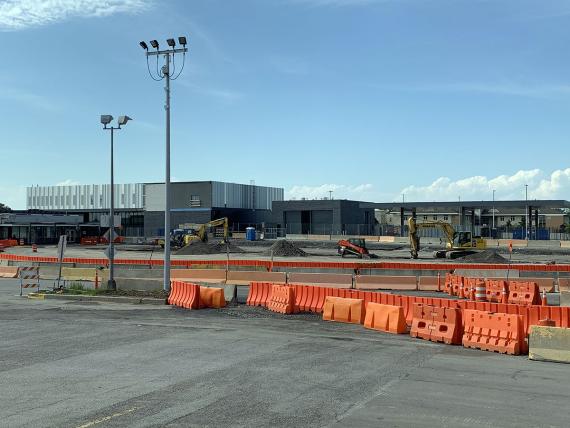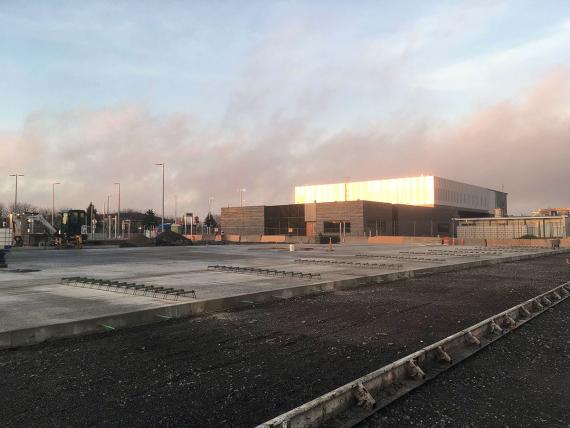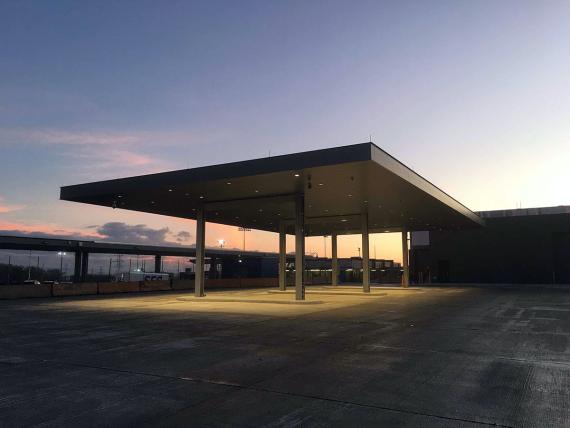Construction and cooperation on the frontlines of COVID-19 – Lewiston Land Port of Entry
Edited by Ben Zabava

GSA’s partnerships with client agencies have been instrumental in keeping the federal government’s most critical construction projects moving forward, in spite of the challenge of COVID-19. Such is the case even in Region 2, for so long comprising much of the epicenter of the pandemic in the United States.
“Our region’s federal construction projects are some of the largest in the country,” said GSA Region 2 Administrator John A. Sarcone, III. “I am truly proud of the hundreds of workers we have helped keep employed throughout this pandemic, and of the impact continuing this work is having on our local economy and the spirit of our nation.”
The following is the second of a three-part series of interviews conducted with GSA project managers and client agency officials to obtain their perspectives on the status of the region’s major construction projects during COVID-19.
In Part 2, Chief Officer Kevin Mann and Facilities Program Manager Carlo Dirienzo of the U.S. Department of Homeland Security - Customs and Border Protection, along with Supervisory Project Manager Andrew Woodring of GSA’s Public Building Service Region 2 Project Management Division, discuss progress on the $80 million modernization and expansion of the U.S. Land Port of Entry leased at Lewiston, New York.
______
How was the Lewiston project progressing before COVID-19?
Carlo Dirienzo, CBP: The project was moving along according to schedule prior to COVID. CBP, GSA, the Niagara Falls Bridge Commission, and the construction contractor were all working well together.
Kevin Mann, CBP: Prior to COVID-19, progress on the project was moving very well. With a project of this magnitude there will always be something that causes a change in your plans. In this case, it was COVID-19.
Andrew Woodring, GSA: Prior to COVID-19, the new Administration Building was tracking to be complete in August 2020. The overall project, inclusive of new inspection lanes, road work, and an export inspection building, was on schedule to be complete by June 2023. There was very little loss of productivity and no major safety incidents.
How has COVID-19 affected the project?
Woodring: COVID-19 forced the contractors to reduce the staffing in accordance with both CDC and, since this is a leased location, New York State safety guidelines. Paths of travel within the project changed to a single direction to avoid people coming into contact with one another. Production rates reduced because of these measures, but work was never stopped.
Mann: COVID-19 has obviously caused the project to slow a bit and required additional precautions to protect everyone involved. The construction team had to change the way they work when it came to the interior work on the project. They went from close to 70 tradespeople on a single shift, to 25-30 working on two separate shifts.

Dirienzo: There are interior and exterior portions of the project. While working outside, contractors had their workforce maintain a six foot separation as much as possible or wear personal protective equipment if that distance was not feasible due to the nature of the work. Precautionary measures were also put in place to encourage as much social distancing as possible while inside the building. The maximum number of workers decreased to 50% of peak numbers prior to COVID, and corridors and stairways became one-way traffic.
What has been the biggest adjustment made to the project?
Mann: The biggest adjustment has been the phasing of the work being performed. Quite a bit of site work scheduled for a year away was moved up to now instead, since the U.S./Canadian border restrictions on travel created a window of temporarily lessened traffic and more space in which to work. This work has greatly changed the look of the plaza and the way vehicles move through it.
Dirienzo: The biggest adjustment has been trying to work on a major construction project while maintaining good social distancing practices. The nature of this work sometimes calls for people to work in close proximity to each other and all stakeholders have done a great job of balancing productivity with worker safety.
Woodring: The contractor takes safety seriously, and it showed with the firm’s willingness to put in measures that could have hurt the project schedule. Many construction activities require two or more people to perform, which was not easy to do. The staff adjusted, prioritized work they could do safely, and pressed on despite the unanticipated challenge of COVID-19.
How currently complete is the project?
Woodring: The project is currently 53% complete.
How happy are you with the work being done and current schedule of the project?
Mann: We are very happy with the work being done by the team. No one could have predicted the impact of COVID-19, but everyone involved has worked together to ensure project completion is safe and efficient.
Dirienzo: The quality of work has been outstanding. It is never easy to see a construction schedule slip but knowing the workers are able to leave the jobsite safe at the end of their shift outweighs any schedule delays.
Is the project on schedule? What is the current projected completion date?
Woodring: While circumstances delayed certain milestones, the new Administration Building is still on track to be complete in August 2020, and the overall schedule is still on track for a June 2023 completion.
Mann: The current expected completion date for the entire project is June 2023.

Why is the project important to CBP?
Mann: The project is important to CBP because it will allow us to more efficiently process legitimate trade and travel, while providing significant upgrades to our infrastructure and abilities to safeguard the United States.
Dirienzo: The Lewiston Land Port of Entry is a very busy one, processing 1.2 million vehicles and 380,000 trucks annually on the northern border. The port has had few upgrades since being built in the 1960s. The infrastructure of the existing port as well as the traffic patterns are out-of-date and inefficient. The new port will allow CBP to more efficiently perform its mission while increasing the security and traffic flow.
As a GSA employee, why are you proud of the project?
Woodring: The work being performed by the contractors is of very high quality and they have maintained a very clean and safe site. Even though it is an active construction site, you can clearly see that it is organized and the different groups are working with a single goal.
Is there any last thing you would like to say about this project?
Dirienzo: I want to reiterate the tremendous job that the Niagara Falls Bridge Commission and the construction contractor have done on this project. All projects of this size encounter some adversity, but I have never worked on any that have had to endure a global pandemic.
Woodring: This is a very logistically challenging project. Construction of a new building and lanes in the middle of an active port requires close coordination with the tenants, the traveling public, and the contractor team. All sides have been very flexible, especially with the new challenges of COVID-19. We are lucky to have the team that we do.
For more information about GSA design and construction services, please visit: gsa.gov/real-estate/design-and-construction.
______
Construction and cooperation on the frontlines of COVID-19
The complete three-part series:

 U.S. General Services Administration
U.S. General Services Administration